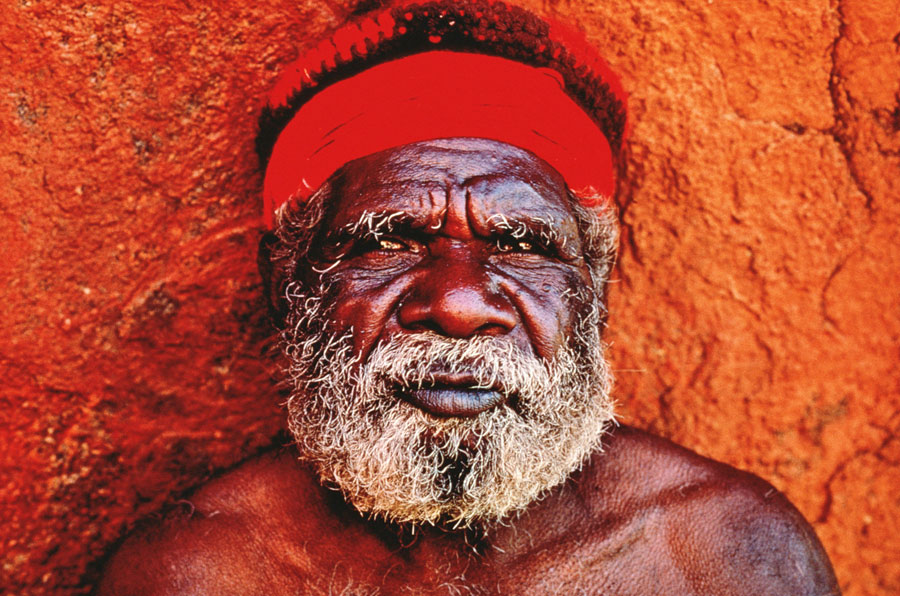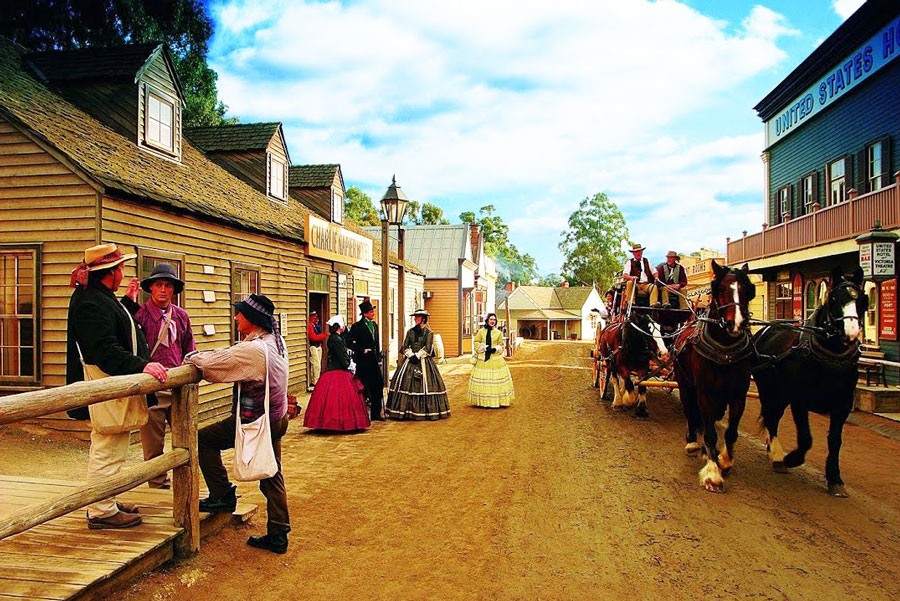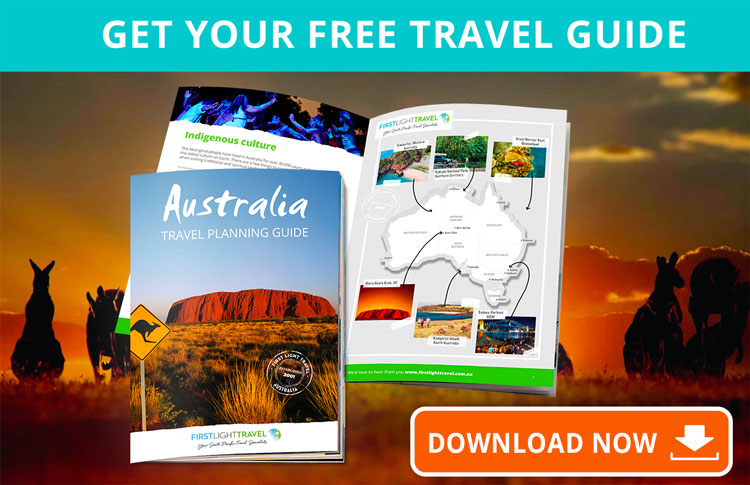In the beginning 60,000 years ago - Before contact
Aboriginal peoples are the oldest surviving culture in the world, having established ways of managing their land and society that were sustainable and ensured good health. They have occupied Australia for at least 60,000 years. While there were significant contact and trade between the diverse peoples who inhabited this continent, there was no contact, no exchange of cultures or knowledge between Indigenous Australians and the rest of the world.
The Aborigines were a hunter-gatherer society. However, dingoes were domesticated about 4,000-3,000 BC. The Aborigines hunted with wooden spears and sometimes with stone or bone blades. They also used nets. As well as hunting mammals they hunted reptiles such as snakes and lizards. Aborigines also ate insects and eggs. They also hunted birds such as ducks, parrots, cockatoos, and emus. Aborigines dug up roots and collected fruits and nuts. Although European settlers regarded them as primitive in fact Aborigines survived in Australia for tens of thousands of years and they had a rich culture. However in 1770 when Captain Cook arrived in Botany Bay. He claimed the whole of Australia (or New South Wales) for Britain. To Cook and his contemporaries, Australia was terra nullius or empty land (ignoring the Aborigines who lived there!).

The First Convicts Transported To Australia
During the 17th century and 18th century, European explorers reached Australia. In 1770 Captain Cook claimed eastern Australia for Britain. He called it New South Wales.
Life was hard for ordinary people in the 18th century and punishments for even minor crimes were severe. In England, you could be hanged for more than 200 different offenses. However, as an alternative to hanging prisoners were sometimes sentenced to transportation. In the 18th century, convicts were transported to Virginia and Maryland in what is now the USA. Transportation was a relatively humane punishment. At any rate, it was better than hanging!
However, after the American War of Independence (1775-1783) this was no longer possible and the government began looking for a new destination for transportees. In 1786 it was decided to send them to Botany Bay. Getting rid of undesirable members of society may not have been the sole motive for founding a colony in Australia. The British may have hoped to found a naval base in the Pacific. They also hoped Australia would be a source of timber and flax.
At any rate, on 13 May 1787 a fleet of 11 ships set sail from Portsmouth in the UK. On board were 759 convicts, mostly men, with sailors and marines to guard the prisoners. Captain Arthur Phillip commanded them. With them, they brought seeds, farm implements, livestock such as cattle, sheep, pigs, goats, horses and chickens and 2 years supply of food. The first colonists came ashore at Port Jackson on 26 January 1788.
At first things were difficult for the colonists, and food was short, although Phillip sent a ship to South Africa for more provisions which returned in May 1789. Food was rationed and the rations were anything but generous. However, things gradually improved. A second fleet arrived in 1790 and a third fleet came in 1791. At first, the settlers lived in simple wooden huts but later convicts made bricks for houses.
Captain Phillip left Australia in December 1792. When he returned to England he took samples of Australian plants and animals. He also took two indigenous people.
Early convicts worked on government land for provisions, but from 1793, those who behaved well were freed and given grants of land. Also, the first free settlers arrived in 1793. Although hopes of growing flax in Australia came to nothing, whales were hunted in the Pacific and seals were hunted in the Bass Strait.

Australia in the Early 19th Century
Relatively few new people were sent to Australia during the long wars with France from 1793 to 1815, because the war at sea made that difficult. Nevertheless, the colony continued to grow. The second governor of Australia was John Hunter 1795-1800. He was followed by Philip King 1800-1806. Under King, the first colonists settled in Van Diemen's Land (Tasmania) in 1803. In 1804 a new settlement was founded at Newcastle for convicts who committed a second offense.
In 1813 Europeans discovered a pass through the Blue Mountains. That enabled them to spread inland. Berrima was founded in 1829. Bathurst and Goulburn followed it in 1833. By 1825 the White population of Australia was about 25,000 while Tasmania had a population of about 4,500. Transportation to New South Wales ended in 1840. Transportation to Australia ended completely in 1868. Meanwhile, the system of granting land to people ended in 1831. From then on land in Australia was sold.
Australia in the Late 19th Century
In the late 19th century Northern Australia began to grow. Darwin was founded in 1869. In 1872 an overland telegraph was made from Darwin to Adelaide. Cattle were very important to the northern economy. Because of the hot climate, there were also sugar plantations. In 1901 the population of Australia was 3,370,000. The largest city was Melbourne with a population of about 420,000. The second was Sydney with about 360,000. Adelaide had about 115,000 and Brisbane 86,000. Hobart was much smaller with just 34,000 people.
Meanwhile, Australia had gained its first universities. Sydney University was founded in 1850. It was followed by Melbourne University in 1853 and Adelaide University in 1874. There was also a railway boom in Australia in the late 19th century. Although the first railways in Australia were built in the early 1850s there were still only about 1,600 miles of railway in 1875. By 1891 there were over 10,000 miles of railway.
Communications also improved with the invention of the telephone. The first telephone call in Australia was made in Melbourne in 1878. Telephone exchanges opened in Melbourne and Brisbane (1880), Sydney (1881), Adelaide, Hobart and Launceston (1883) and Perth (1887). However in the 1890s Australia suffered a recession, which was compounded by drought in the late 1890s. Not surprisingly immigration fell dramatically during the decade.
On the other hand, gold was found in Western Australia in 1882. Another find in 1892 led to a gold rush. However this time the gold was exploited by large companies rather than by lone prospectors. The population of Western Australia boomed as a result of the gold rush.

Australia in the 21st Century
Today the population of Australia is 23 million. In 2006 it was estimated that the indigenous population was about 500,000 - about the same as it was when Europeans first arrived in Australia at the end of the 18th century.
Unemployment was high in the 1990s but at the beginning of the 21st century the situation improved. Unemployment in Australia stood at 5.2% in March 2012. However by November 2015 it had fallen to 5.8%. Today Australia is a prosperous country.
In 2008 Quentin Bryce became the first female Governor-General of Australia. In 2010 Julia Gillard became the first female Prime Minister of Australia.
Read more about contemporary Australia and its people.
More articles to help you plan your trip to Australia
Getting to Australia
What is the Best Time to Visit Australia
How Long Should I Visit Australia For
Australian Passport and Visa Requirements
Smooth as possible on arrival to Australia
Travel Insurance for Australia
Driving in Australia
Safety in Australia's Great Outdoors
What to Pack for an Australian Holiday
Australian Accommodation Guide
Australia's Need to Know Facts
What do things cost in Australia
Since 2001 we’ve been helping visitors plan their dream Australian holiday. We aim to make visiting our beautiful land effortless. Let our expert holiday planners put together an itinerary for you, no obligation FREE of charge, or get some friendly advice on what small group tour would suit - Just follow the link and answer a few brief questions



